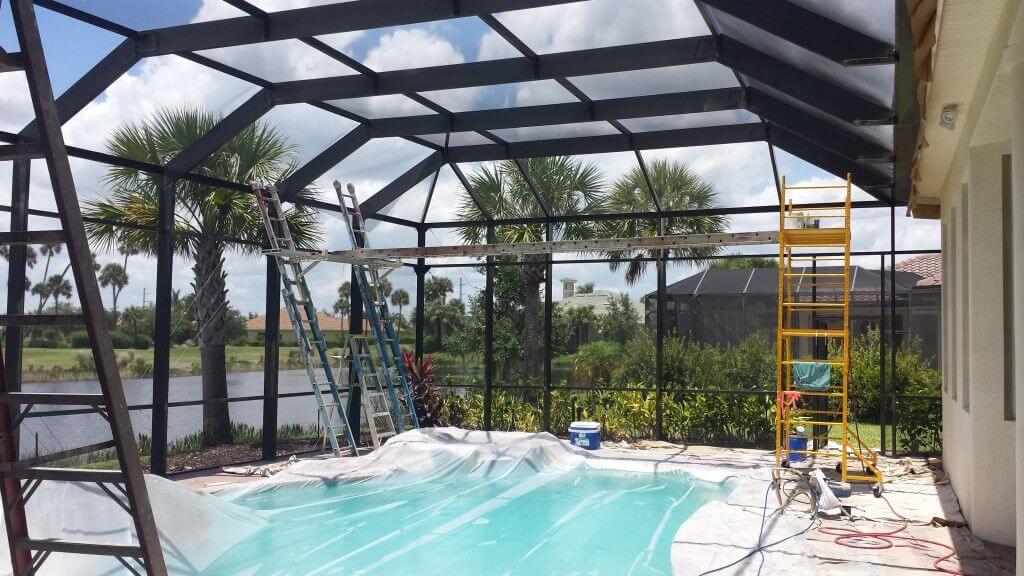If you’re looking for a fun weekend project that will spruce up your home, consider painting your screen enclosure. This guide will walk you through the process of how to paint screen enclosure, from prep work to choosing the right paint. With just a few supplies and some elbow grease, you can have a fresh new look for your outdoor space in no time.
- Clean the screen enclosure with a hose and brush to remove any dirt or debris
- Use a ladder to reach the top of the screen enclosure and paint the trim with an exterior paint
- Paint the rest of the screen enclosure with a roller, being sure to evenly cover all surfaces
- Allow the paint to dry completely before using the screen enclosure again

Credit: www.ronspainting.com
How Do I Prepare the Surface for Painting
Preparing the surface for painting is a crucial step in ensuring a high-quality, professional finish. Here are some tips on how to prepare the surface for painting:
1. Start with a clean surface.
Before you begin painting, it’s important to make sure the surface you’re working on is clean. Any dirt, grease, or other contaminants will impede the paint’s ability to adhere properly and can cause issues down the road. To clean the surface, simply wipe it down with a damp cloth or mild soap and water solution.
2. Remove any loose paint or wallpaper. If there’s any loose paint or wallpaper on the surface you’re working on, it’s important to remove it before proceeding. This will ensure that your new paint job has a solid foundation to work from and will minimize the risk of peeling or flaking later on.
You can remove loose paint by scraping it away with a putty knife or sanding it down with fine-grit sandpaper until smooth. For wallpaper, use a scoring tool to perforate the paper so that water can more easily penetrate and loosen its grip before stripping it away.
Prime bare surfaces . Once you’ve removed all loose materials from the surface , you’ll need to prime any bare spots where new paint will be applied . This helps create an even base for your new color and ensures better coverage .
You can choose from latex or oil – based primers depending on your project needs . Simply apply primer using a roller or brush according to manufacturer ‘s instructions and allow it to dry completely before continuing .
What Type of Paint Should I Use
There are a few different types of paint that can be used on walls, and each has its own benefits and drawbacks. Here is a brief overview of some of the most popular types of paint:
– latex paint is water-based and easy to clean up; it dries quickly and doesn’t have an offensive smell.
However, it isn’t as durable as oil-based paints, so it may need to be reapplied more often.
– oil-based paint takes longer to dry but is more durable than latex paint. It also tends to yellow over time.
– acrylic paint is similar to latex paint but dries even faster. It’s also non-toxic, making it a good choice for homes with children or pets. However, it isn’t as durable as oil-based paints.
Picking the right type of paint depends on your needs and preferences. If you’re looking for an easy-to-use product that dries quickly, latex or acrylic paints are probably your best bet. If you need something more durable, then oil-based paints are a better option.
How Many Coats of Paint Will I Need
This is a difficult question to answer without more information. Factors such as the type of paint, the color, the surface being painted and the paint’s opacity all play a role in how many coats will be necessary. A good rule of thumb is usually two to three coats, but more may be needed for darker colors or for surfaces that require more coverage.
Best Way to Paint & Restore a Pool Cage
Conclusion
If your screened enclosure is in dire need of a new paint job, don’t despair. With a little time and elbow grease, you can have it looking like new again. Here’s how to go about painting your screen enclosure:
1. Start by thoroughly cleaning the screens with soap and water. This will help the paint adhere better.
2. Next, use a primer specifically designed for screens.
This will help the paint last longer and look better.
3. Once the primer is dry, you’re ready to start painting! Use a brush or roller specifically made for painting screens.
These have shorter bristles that won’t damage the mesh.
4. Paint in even strokes, going with the grain of the mesh. Don’t forget to paint the underside of any horizontal surfaces (such as ledges) so that they won’t show through when viewed from below.
